Fair and Equitable Treatment Standard in Investment Treaty Practice
VerifiedAdded on 2023/04/25
|9
|1666
|313
Report
AI Summary
This report provides a comprehensive analysis of the Fair and Equitable Treatment (FET) standard in international investment law. It explores five different interpretations of the FET standard in investment treaty practice, focusing on its role as a safeguard against injustice towards foreign investors and its function as a crucial rule in universal investment law. The report also addresses the unconditional nature of the FET standard and its key components, such as the prohibition of denial of fairness and the restriction of arbitrary measures. Furthermore, the report delves into scenarios involving arbitrator independence and potential conflicts of interest, discussing how an arbitrator should handle situations such as having a substantial shareholding in the parent company of the claimant or having a close friendship with a member of the respondent's legal team. It references relevant case law, legislation, and soft law instruments, such as the Arbitration Act 1996 and the IBA Guidelines on Conflicts of Interest in International Arbitration, to support its analysis and recommendations.
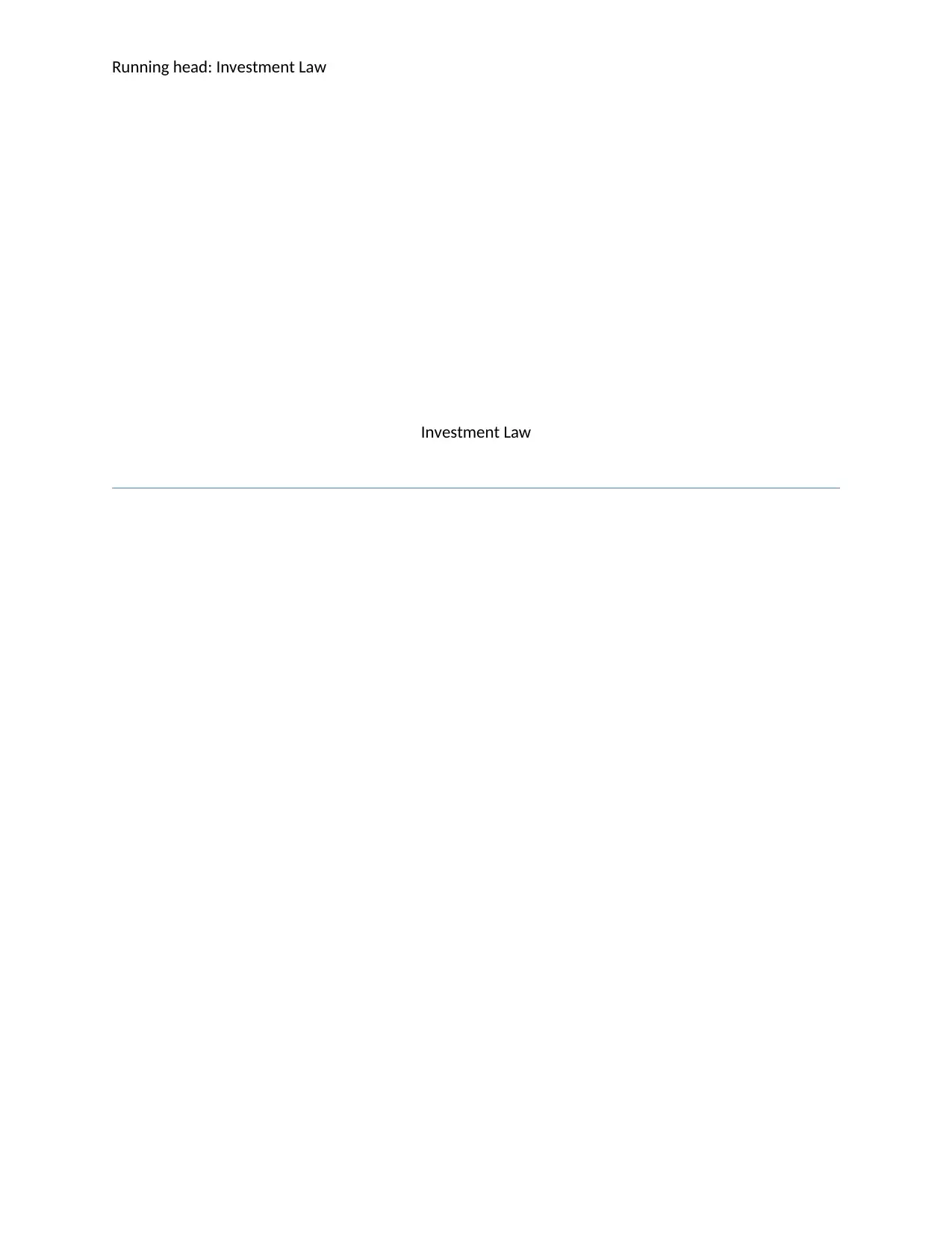
Running head: Investment Law
Investment Law
Investment Law
Paraphrase This Document
Need a fresh take? Get an instant paraphrase of this document with our AI Paraphraser
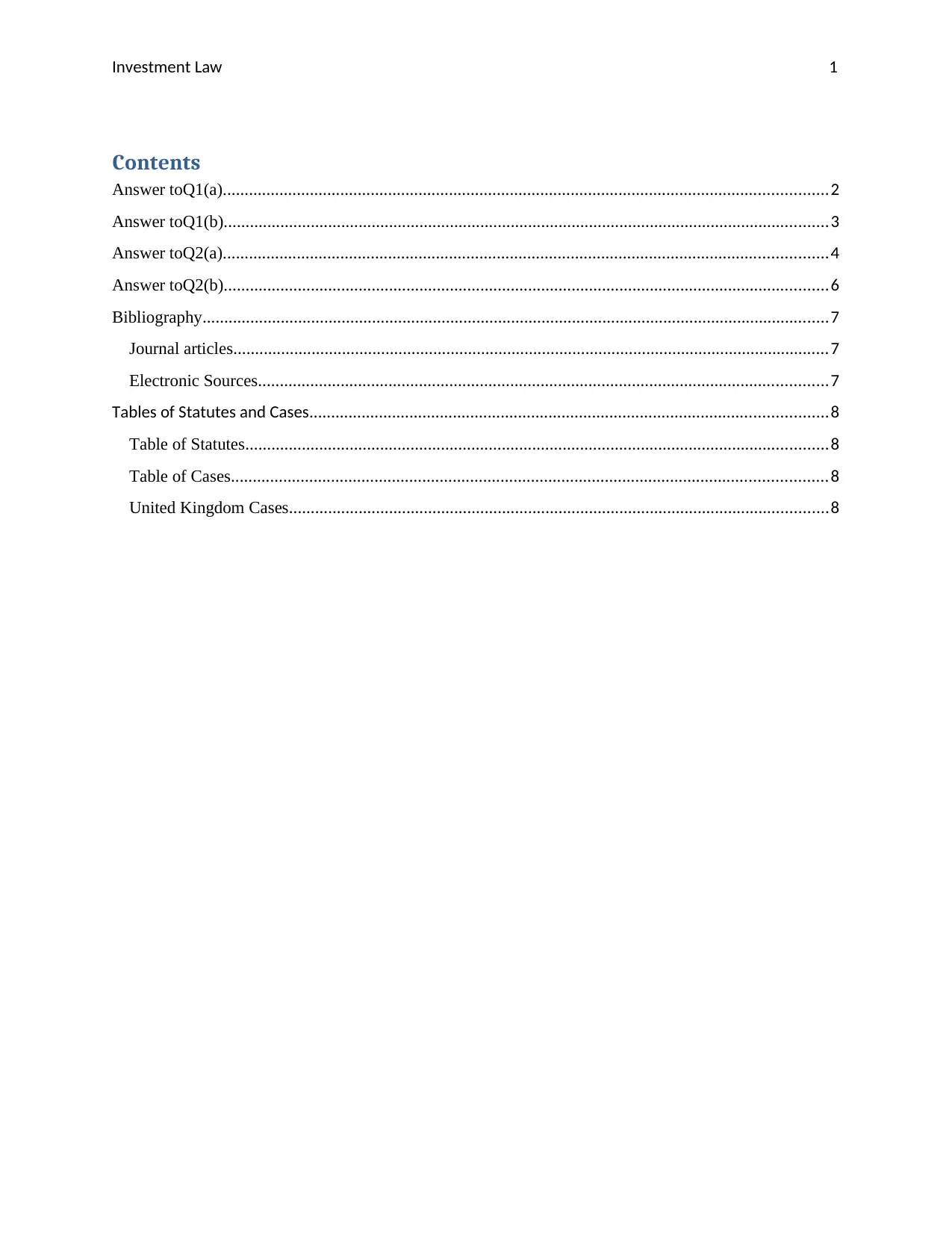
Investment Law 1
Contents
Answer toQ1(a)...........................................................................................................................................2
Answer toQ1(b)...........................................................................................................................................3
Answer toQ2(a)...........................................................................................................................................4
Answer toQ2(b)...........................................................................................................................................6
Bibliography................................................................................................................................................7
Journal articles.........................................................................................................................................7
Electronic Sources...................................................................................................................................7
Tables of Statutes and Cases.......................................................................................................................8
Table of Statutes......................................................................................................................................8
Table of Cases.........................................................................................................................................8
United Kingdom Cases............................................................................................................................8
Contents
Answer toQ1(a)...........................................................................................................................................2
Answer toQ1(b)...........................................................................................................................................3
Answer toQ2(a)...........................................................................................................................................4
Answer toQ2(b)...........................................................................................................................................6
Bibliography................................................................................................................................................7
Journal articles.........................................................................................................................................7
Electronic Sources...................................................................................................................................7
Tables of Statutes and Cases.......................................................................................................................8
Table of Statutes......................................................................................................................................8
Table of Cases.........................................................................................................................................8
United Kingdom Cases............................................................................................................................8
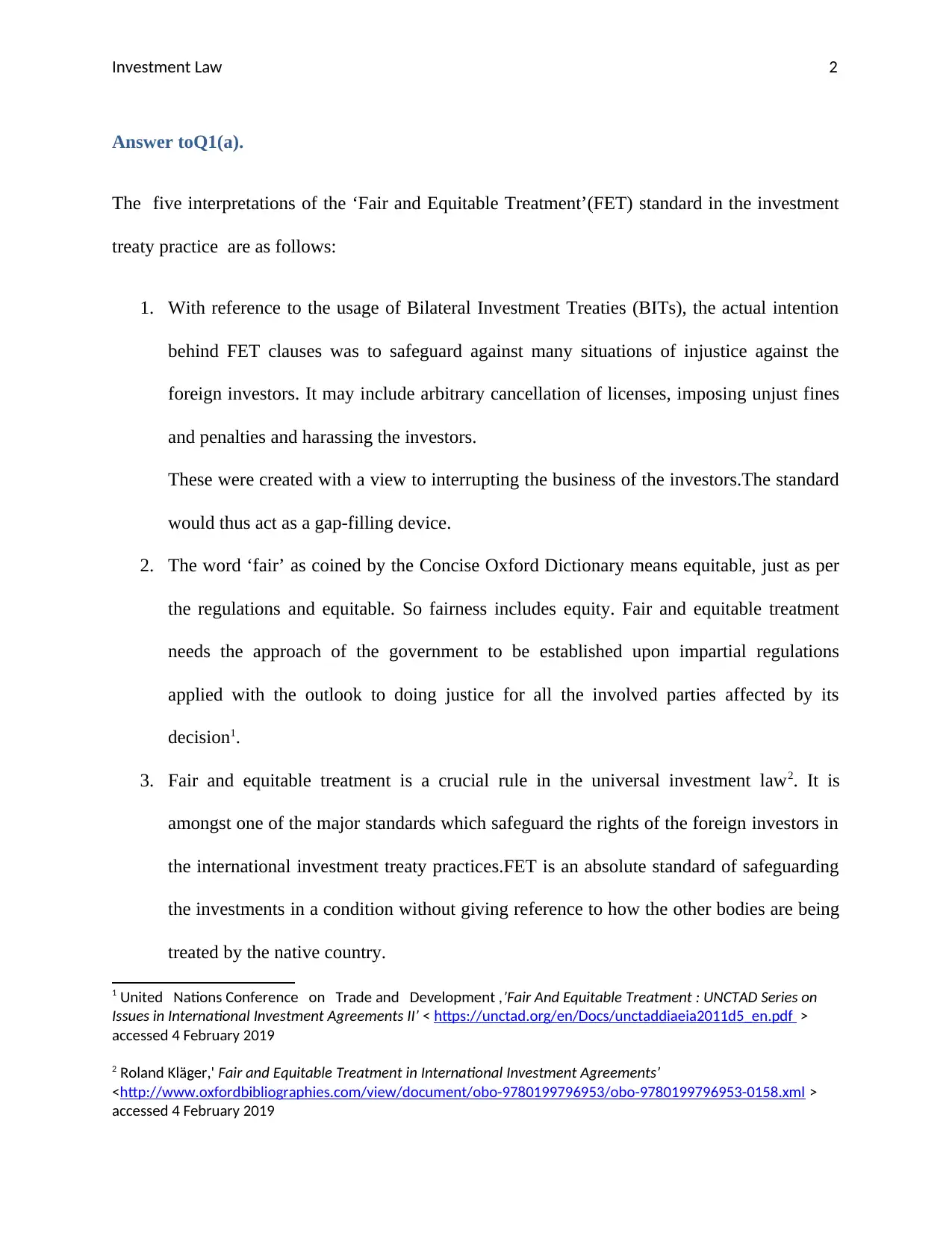
Investment Law 2
Answer toQ1(a).
The five interpretations of the ‘Fair and Equitable Treatment’(FET) standard in the investment
treaty practice are as follows:
1. With reference to the usage of Bilateral Investment Treaties (BITs), the actual intention
behind FET clauses was to safeguard against many situations of injustice against the
foreign investors. It may include arbitrary cancellation of licenses, imposing unjust fines
and penalties and harassing the investors.
These were created with a view to interrupting the business of the investors.The standard
would thus act as a gap-filling device.
2. The word ‘fair’ as coined by the Concise Oxford Dictionary means equitable, just as per
the regulations and equitable. So fairness includes equity. Fair and equitable treatment
needs the approach of the government to be established upon impartial regulations
applied with the outlook to doing justice for all the involved parties affected by its
decision1.
3. Fair and equitable treatment is a crucial rule in the universal investment law2. It is
amongst one of the major standards which safeguard the rights of the foreign investors in
the international investment treaty practices.FET is an absolute standard of safeguarding
the investments in a condition without giving reference to how the other bodies are being
treated by the native country.
1 United Nations Conference on Trade and Development ,’Fair And Equitable Treatment : UNCTAD Series on
Issues in International Investment Agreements II’ < https://unctad.org/en/Docs/unctaddiaeia2011d5_en.pdf >
accessed 4 February 2019
2 Roland Kläger,' Fair and Equitable Treatment in International Investment Agreements’
<http://www.oxfordbibliographies.com/view/document/obo-9780199796953/obo-9780199796953-0158.xml >
accessed 4 February 2019
Answer toQ1(a).
The five interpretations of the ‘Fair and Equitable Treatment’(FET) standard in the investment
treaty practice are as follows:
1. With reference to the usage of Bilateral Investment Treaties (BITs), the actual intention
behind FET clauses was to safeguard against many situations of injustice against the
foreign investors. It may include arbitrary cancellation of licenses, imposing unjust fines
and penalties and harassing the investors.
These were created with a view to interrupting the business of the investors.The standard
would thus act as a gap-filling device.
2. The word ‘fair’ as coined by the Concise Oxford Dictionary means equitable, just as per
the regulations and equitable. So fairness includes equity. Fair and equitable treatment
needs the approach of the government to be established upon impartial regulations
applied with the outlook to doing justice for all the involved parties affected by its
decision1.
3. Fair and equitable treatment is a crucial rule in the universal investment law2. It is
amongst one of the major standards which safeguard the rights of the foreign investors in
the international investment treaty practices.FET is an absolute standard of safeguarding
the investments in a condition without giving reference to how the other bodies are being
treated by the native country.
1 United Nations Conference on Trade and Development ,’Fair And Equitable Treatment : UNCTAD Series on
Issues in International Investment Agreements II’ < https://unctad.org/en/Docs/unctaddiaeia2011d5_en.pdf >
accessed 4 February 2019
2 Roland Kläger,' Fair and Equitable Treatment in International Investment Agreements’
<http://www.oxfordbibliographies.com/view/document/obo-9780199796953/obo-9780199796953-0158.xml >
accessed 4 February 2019
⊘ This is a preview!⊘
Do you want full access?
Subscribe today to unlock all pages.

Trusted by 1+ million students worldwide
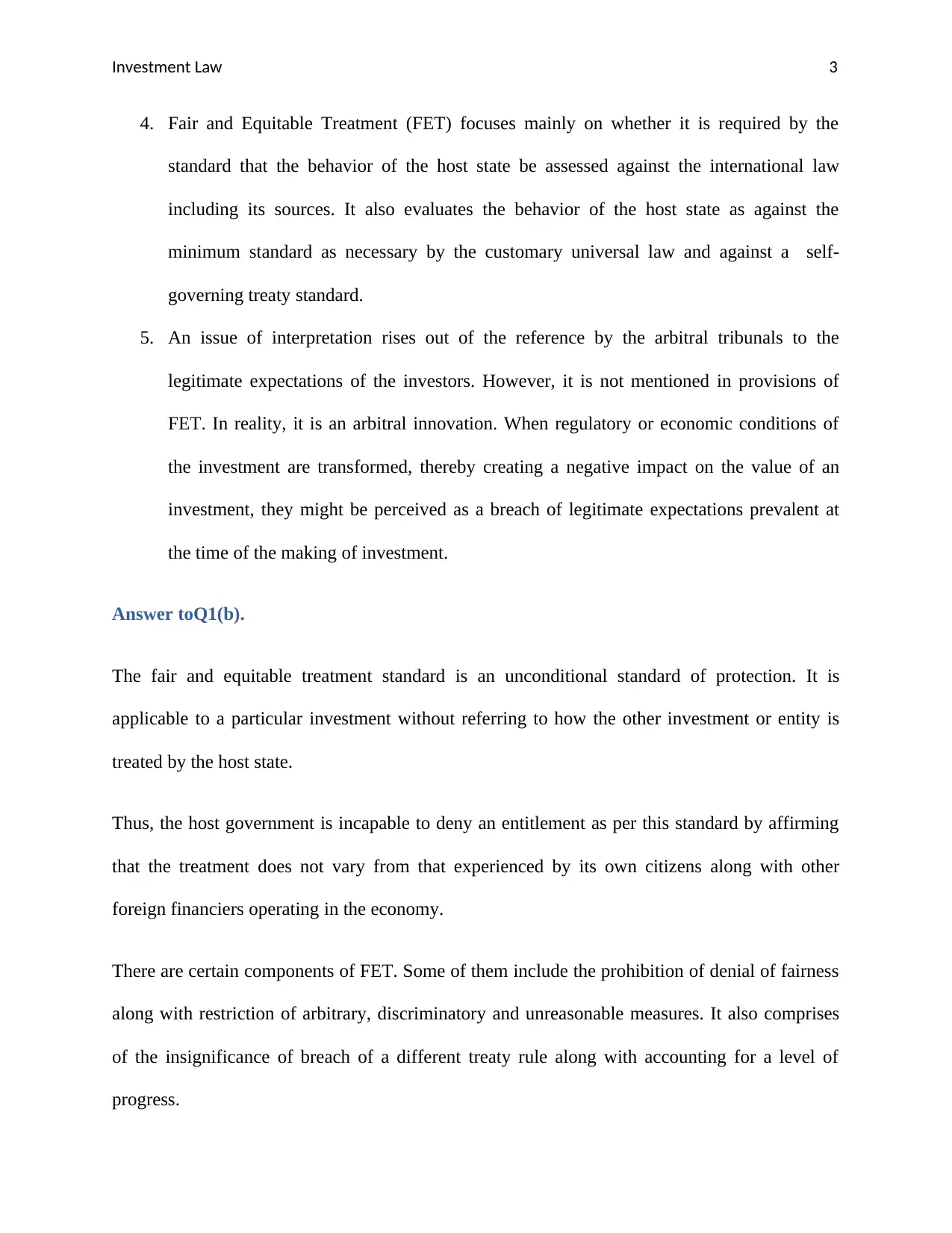
Investment Law 3
4. Fair and Equitable Treatment (FET) focuses mainly on whether it is required by the
standard that the behavior of the host state be assessed against the international law
including its sources. It also evaluates the behavior of the host state as against the
minimum standard as necessary by the customary universal law and against a self-
governing treaty standard.
5. An issue of interpretation rises out of the reference by the arbitral tribunals to the
legitimate expectations of the investors. However, it is not mentioned in provisions of
FET. In reality, it is an arbitral innovation. When regulatory or economic conditions of
the investment are transformed, thereby creating a negative impact on the value of an
investment, they might be perceived as a breach of legitimate expectations prevalent at
the time of the making of investment.
Answer toQ1(b).
The fair and equitable treatment standard is an unconditional standard of protection. It is
applicable to a particular investment without referring to how the other investment or entity is
treated by the host state.
Thus, the host government is incapable to deny an entitlement as per this standard by affirming
that the treatment does not vary from that experienced by its own citizens along with other
foreign financiers operating in the economy.
There are certain components of FET. Some of them include the prohibition of denial of fairness
along with restriction of arbitrary, discriminatory and unreasonable measures. It also comprises
of the insignificance of breach of a different treaty rule along with accounting for a level of
progress.
4. Fair and Equitable Treatment (FET) focuses mainly on whether it is required by the
standard that the behavior of the host state be assessed against the international law
including its sources. It also evaluates the behavior of the host state as against the
minimum standard as necessary by the customary universal law and against a self-
governing treaty standard.
5. An issue of interpretation rises out of the reference by the arbitral tribunals to the
legitimate expectations of the investors. However, it is not mentioned in provisions of
FET. In reality, it is an arbitral innovation. When regulatory or economic conditions of
the investment are transformed, thereby creating a negative impact on the value of an
investment, they might be perceived as a breach of legitimate expectations prevalent at
the time of the making of investment.
Answer toQ1(b).
The fair and equitable treatment standard is an unconditional standard of protection. It is
applicable to a particular investment without referring to how the other investment or entity is
treated by the host state.
Thus, the host government is incapable to deny an entitlement as per this standard by affirming
that the treatment does not vary from that experienced by its own citizens along with other
foreign financiers operating in the economy.
There are certain components of FET. Some of them include the prohibition of denial of fairness
along with restriction of arbitrary, discriminatory and unreasonable measures. It also comprises
of the insignificance of breach of a different treaty rule along with accounting for a level of
progress.
Paraphrase This Document
Need a fresh take? Get an instant paraphrase of this document with our AI Paraphraser
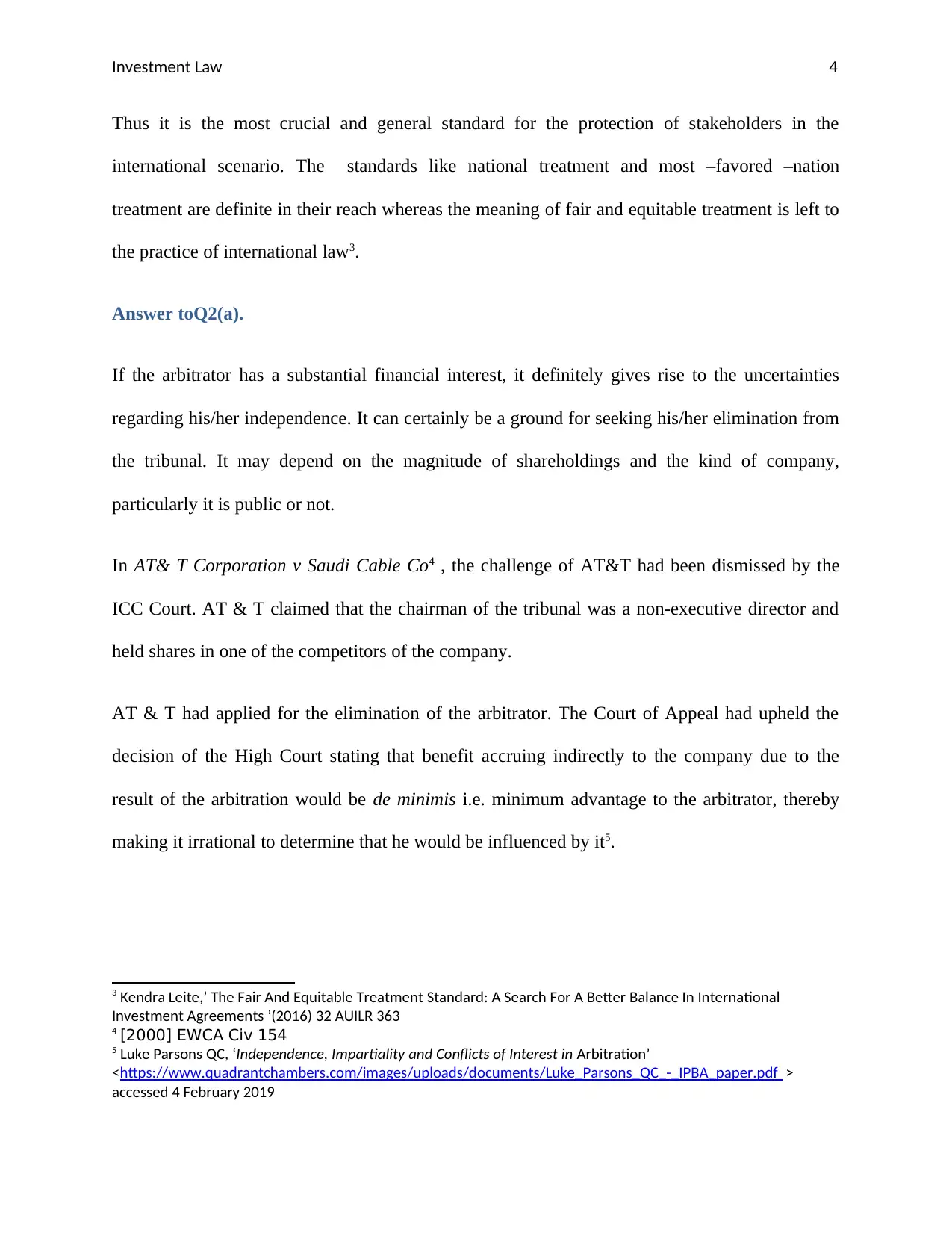
Investment Law 4
Thus it is the most crucial and general standard for the protection of stakeholders in the
international scenario. The standards like national treatment and most –favored –nation
treatment are definite in their reach whereas the meaning of fair and equitable treatment is left to
the practice of international law3.
Answer toQ2(a).
If the arbitrator has a substantial financial interest, it definitely gives rise to the uncertainties
regarding his/her independence. It can certainly be a ground for seeking his/her elimination from
the tribunal. It may depend on the magnitude of shareholdings and the kind of company,
particularly it is public or not.
In AT& T Corporation v Saudi Cable Co4 , the challenge of AT&T had been dismissed by the
ICC Court. AT & T claimed that the chairman of the tribunal was a non-executive director and
held shares in one of the competitors of the company.
AT & T had applied for the elimination of the arbitrator. The Court of Appeal had upheld the
decision of the High Court stating that benefit accruing indirectly to the company due to the
result of the arbitration would be de minimis i.e. minimum advantage to the arbitrator, thereby
making it irrational to determine that he would be influenced by it5.
3 Kendra Leite,’ The Fair And Equitable Treatment Standard: A Search For A Better Balance In International
Investment Agreements ’(2016) 32 AUILR 363
4 [2000] EWCA Civ 154
5 Luke Parsons QC, ‘Independence, Impartiality and Conflicts of Interest in Arbitration’
<https://www.quadrantchambers.com/images/uploads/documents/Luke_Parsons_QC_-_IPBA_paper.pdf >
accessed 4 February 2019
Thus it is the most crucial and general standard for the protection of stakeholders in the
international scenario. The standards like national treatment and most –favored –nation
treatment are definite in their reach whereas the meaning of fair and equitable treatment is left to
the practice of international law3.
Answer toQ2(a).
If the arbitrator has a substantial financial interest, it definitely gives rise to the uncertainties
regarding his/her independence. It can certainly be a ground for seeking his/her elimination from
the tribunal. It may depend on the magnitude of shareholdings and the kind of company,
particularly it is public or not.
In AT& T Corporation v Saudi Cable Co4 , the challenge of AT&T had been dismissed by the
ICC Court. AT & T claimed that the chairman of the tribunal was a non-executive director and
held shares in one of the competitors of the company.
AT & T had applied for the elimination of the arbitrator. The Court of Appeal had upheld the
decision of the High Court stating that benefit accruing indirectly to the company due to the
result of the arbitration would be de minimis i.e. minimum advantage to the arbitrator, thereby
making it irrational to determine that he would be influenced by it5.
3 Kendra Leite,’ The Fair And Equitable Treatment Standard: A Search For A Better Balance In International
Investment Agreements ’(2016) 32 AUILR 363
4 [2000] EWCA Civ 154
5 Luke Parsons QC, ‘Independence, Impartiality and Conflicts of Interest in Arbitration’
<https://www.quadrantchambers.com/images/uploads/documents/Luke_Parsons_QC_-_IPBA_paper.pdf >
accessed 4 February 2019
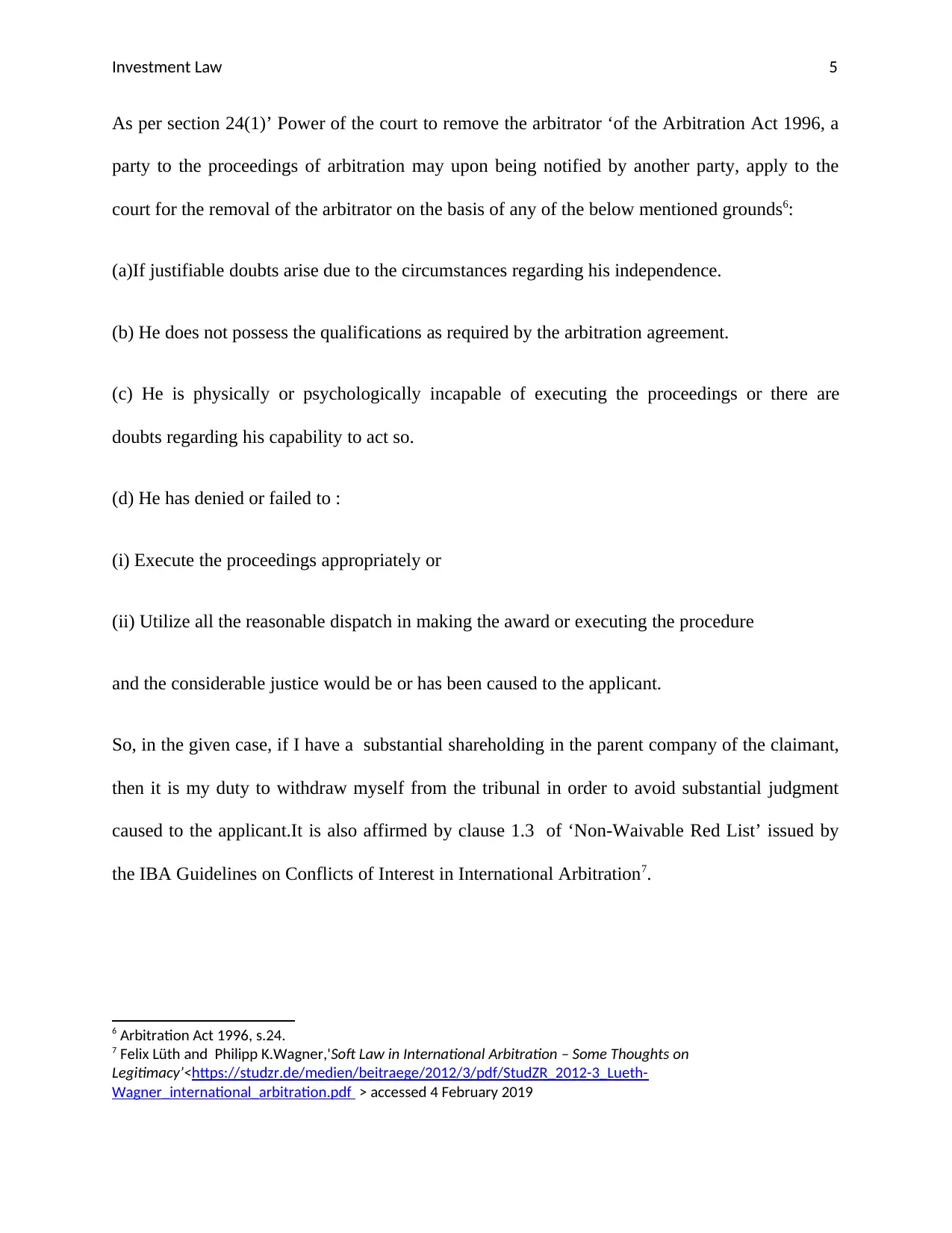
Investment Law 5
As per section 24(1)’ Power of the court to remove the arbitrator ‘of the Arbitration Act 1996, a
party to the proceedings of arbitration may upon being notified by another party, apply to the
court for the removal of the arbitrator on the basis of any of the below mentioned grounds6:
(a)If justifiable doubts arise due to the circumstances regarding his independence.
(b) He does not possess the qualifications as required by the arbitration agreement.
(c) He is physically or psychologically incapable of executing the proceedings or there are
doubts regarding his capability to act so.
(d) He has denied or failed to :
(i) Execute the proceedings appropriately or
(ii) Utilize all the reasonable dispatch in making the award or executing the procedure
and the considerable justice would be or has been caused to the applicant.
So, in the given case, if I have a substantial shareholding in the parent company of the claimant,
then it is my duty to withdraw myself from the tribunal in order to avoid substantial judgment
caused to the applicant.It is also affirmed by clause 1.3 of ‘Non-Waivable Red List’ issued by
the IBA Guidelines on Conflicts of Interest in International Arbitration7.
6 Arbitration Act 1996, s.24.
7 Felix Lüth and Philipp K.Wagner,'Soft Law in International Arbitration – Some Thoughts on
Legitimacy’<https://studzr.de/medien/beitraege/2012/3/pdf/StudZR_2012-3_Lueth-
Wagner_international_arbitration.pdf > accessed 4 February 2019
As per section 24(1)’ Power of the court to remove the arbitrator ‘of the Arbitration Act 1996, a
party to the proceedings of arbitration may upon being notified by another party, apply to the
court for the removal of the arbitrator on the basis of any of the below mentioned grounds6:
(a)If justifiable doubts arise due to the circumstances regarding his independence.
(b) He does not possess the qualifications as required by the arbitration agreement.
(c) He is physically or psychologically incapable of executing the proceedings or there are
doubts regarding his capability to act so.
(d) He has denied or failed to :
(i) Execute the proceedings appropriately or
(ii) Utilize all the reasonable dispatch in making the award or executing the procedure
and the considerable justice would be or has been caused to the applicant.
So, in the given case, if I have a substantial shareholding in the parent company of the claimant,
then it is my duty to withdraw myself from the tribunal in order to avoid substantial judgment
caused to the applicant.It is also affirmed by clause 1.3 of ‘Non-Waivable Red List’ issued by
the IBA Guidelines on Conflicts of Interest in International Arbitration7.
6 Arbitration Act 1996, s.24.
7 Felix Lüth and Philipp K.Wagner,'Soft Law in International Arbitration – Some Thoughts on
Legitimacy’<https://studzr.de/medien/beitraege/2012/3/pdf/StudZR_2012-3_Lueth-
Wagner_international_arbitration.pdf > accessed 4 February 2019
⊘ This is a preview!⊘
Do you want full access?
Subscribe today to unlock all pages.

Trusted by 1+ million students worldwide
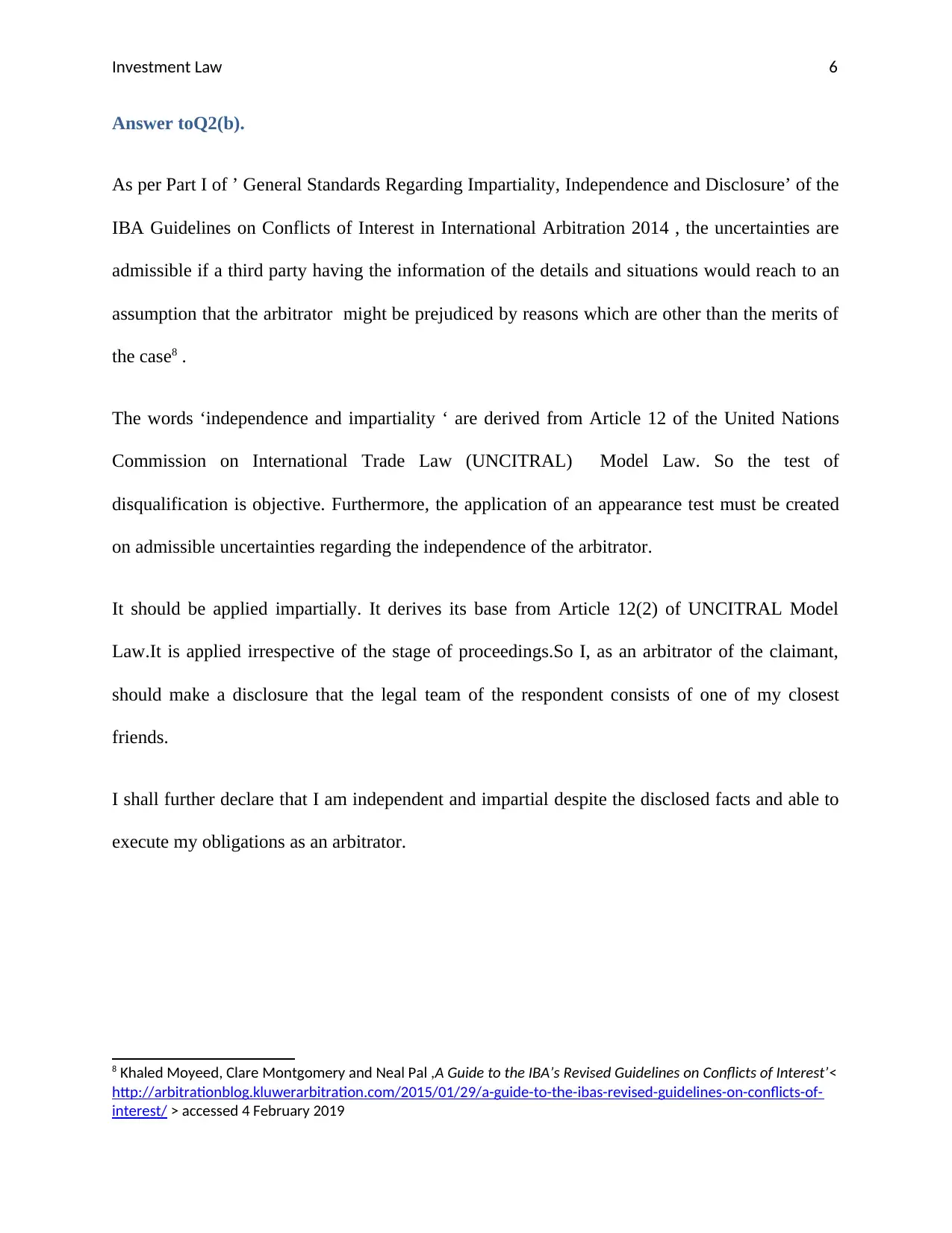
Investment Law 6
Answer toQ2(b).
As per Part I of ’ General Standards Regarding Impartiality, Independence and Disclosure’ of the
IBA Guidelines on Conflicts of Interest in International Arbitration 2014 , the uncertainties are
admissible if a third party having the information of the details and situations would reach to an
assumption that the arbitrator might be prejudiced by reasons which are other than the merits of
the case8 .
The words ‘independence and impartiality ‘ are derived from Article 12 of the United Nations
Commission on International Trade Law (UNCITRAL) Model Law. So the test of
disqualification is objective. Furthermore, the application of an appearance test must be created
on admissible uncertainties regarding the independence of the arbitrator.
It should be applied impartially. It derives its base from Article 12(2) of UNCITRAL Model
Law.It is applied irrespective of the stage of proceedings.So I, as an arbitrator of the claimant,
should make a disclosure that the legal team of the respondent consists of one of my closest
friends.
I shall further declare that I am independent and impartial despite the disclosed facts and able to
execute my obligations as an arbitrator.
8 Khaled Moyeed, Clare Montgomery and Neal Pal ,A Guide to the IBA’s Revised Guidelines on Conflicts of Interest’<
http://arbitrationblog.kluwerarbitration.com/2015/01/29/a-guide-to-the-ibas-revised-guidelines-on-conflicts-of-
interest/ > accessed 4 February 2019
Answer toQ2(b).
As per Part I of ’ General Standards Regarding Impartiality, Independence and Disclosure’ of the
IBA Guidelines on Conflicts of Interest in International Arbitration 2014 , the uncertainties are
admissible if a third party having the information of the details and situations would reach to an
assumption that the arbitrator might be prejudiced by reasons which are other than the merits of
the case8 .
The words ‘independence and impartiality ‘ are derived from Article 12 of the United Nations
Commission on International Trade Law (UNCITRAL) Model Law. So the test of
disqualification is objective. Furthermore, the application of an appearance test must be created
on admissible uncertainties regarding the independence of the arbitrator.
It should be applied impartially. It derives its base from Article 12(2) of UNCITRAL Model
Law.It is applied irrespective of the stage of proceedings.So I, as an arbitrator of the claimant,
should make a disclosure that the legal team of the respondent consists of one of my closest
friends.
I shall further declare that I am independent and impartial despite the disclosed facts and able to
execute my obligations as an arbitrator.
8 Khaled Moyeed, Clare Montgomery and Neal Pal ,A Guide to the IBA’s Revised Guidelines on Conflicts of Interest’<
http://arbitrationblog.kluwerarbitration.com/2015/01/29/a-guide-to-the-ibas-revised-guidelines-on-conflicts-of-
interest/ > accessed 4 February 2019
Paraphrase This Document
Need a fresh take? Get an instant paraphrase of this document with our AI Paraphraser
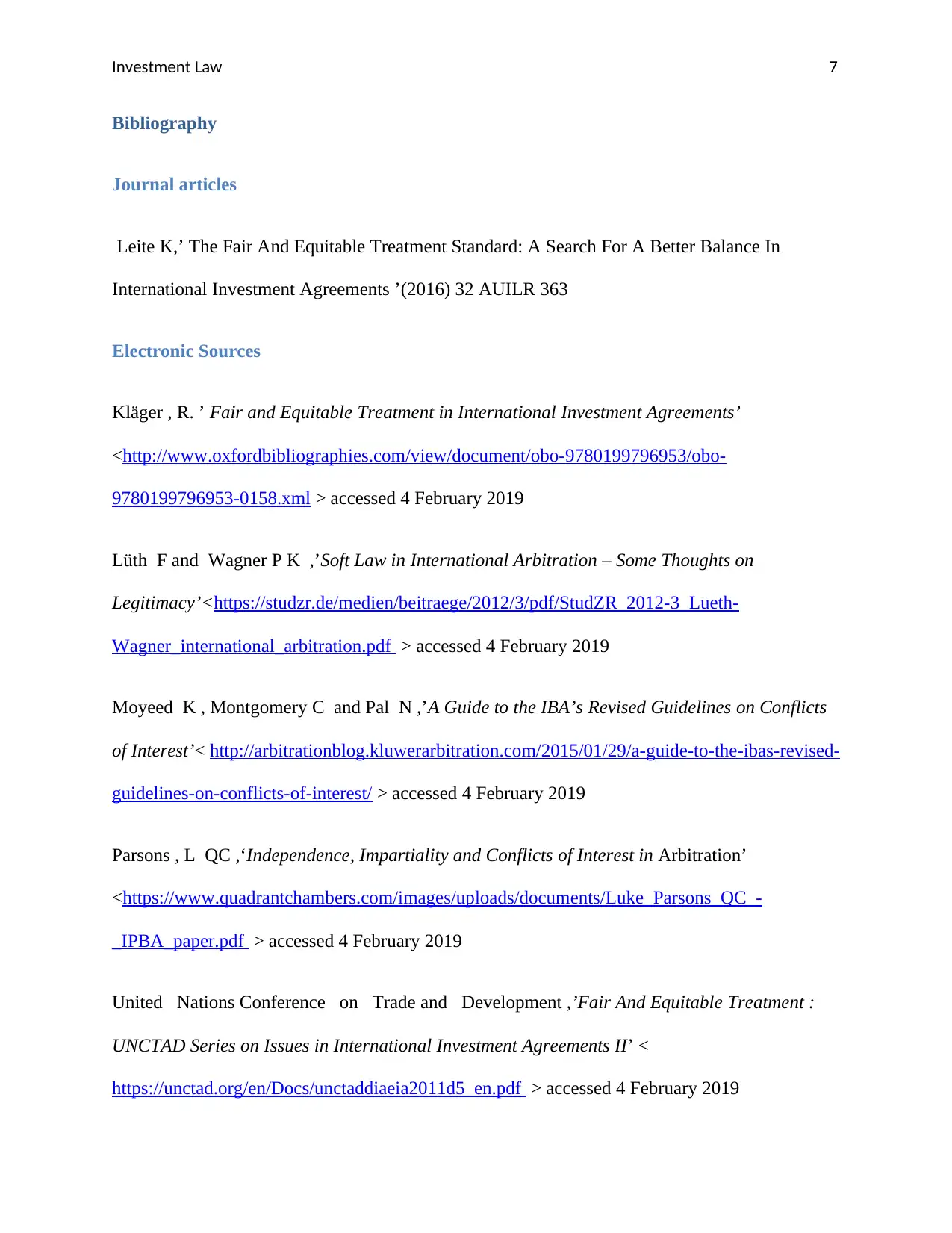
Investment Law 7
Bibliography
Journal articles
Leite K,’ The Fair And Equitable Treatment Standard: A Search For A Better Balance In
International Investment Agreements ’(2016) 32 AUILR 363
Electronic Sources
Kläger , R. ’ Fair and Equitable Treatment in International Investment Agreements’
<http://www.oxfordbibliographies.com/view/document/obo-9780199796953/obo-
9780199796953-0158.xml > accessed 4 February 2019
Lüth F and Wagner P K ,’Soft Law in International Arbitration – Some Thoughts on
Legitimacy’<https://studzr.de/medien/beitraege/2012/3/pdf/StudZR_2012-3_Lueth-
Wagner_international_arbitration.pdf > accessed 4 February 2019
Moyeed K , Montgomery C and Pal N ,’A Guide to the IBA’s Revised Guidelines on Conflicts
of Interest’< http://arbitrationblog.kluwerarbitration.com/2015/01/29/a-guide-to-the-ibas-revised-
guidelines-on-conflicts-of-interest/ > accessed 4 February 2019
Parsons , L QC ,‘Independence, Impartiality and Conflicts of Interest in Arbitration’
<https://www.quadrantchambers.com/images/uploads/documents/Luke_Parsons_QC_-
_IPBA_paper.pdf > accessed 4 February 2019
United Nations Conference on Trade and Development ,’Fair And Equitable Treatment :
UNCTAD Series on Issues in International Investment Agreements II’ <
https://unctad.org/en/Docs/unctaddiaeia2011d5_en.pdf > accessed 4 February 2019
Bibliography
Journal articles
Leite K,’ The Fair And Equitable Treatment Standard: A Search For A Better Balance In
International Investment Agreements ’(2016) 32 AUILR 363
Electronic Sources
Kläger , R. ’ Fair and Equitable Treatment in International Investment Agreements’
<http://www.oxfordbibliographies.com/view/document/obo-9780199796953/obo-
9780199796953-0158.xml > accessed 4 February 2019
Lüth F and Wagner P K ,’Soft Law in International Arbitration – Some Thoughts on
Legitimacy’<https://studzr.de/medien/beitraege/2012/3/pdf/StudZR_2012-3_Lueth-
Wagner_international_arbitration.pdf > accessed 4 February 2019
Moyeed K , Montgomery C and Pal N ,’A Guide to the IBA’s Revised Guidelines on Conflicts
of Interest’< http://arbitrationblog.kluwerarbitration.com/2015/01/29/a-guide-to-the-ibas-revised-
guidelines-on-conflicts-of-interest/ > accessed 4 February 2019
Parsons , L QC ,‘Independence, Impartiality and Conflicts of Interest in Arbitration’
<https://www.quadrantchambers.com/images/uploads/documents/Luke_Parsons_QC_-
_IPBA_paper.pdf > accessed 4 February 2019
United Nations Conference on Trade and Development ,’Fair And Equitable Treatment :
UNCTAD Series on Issues in International Investment Agreements II’ <
https://unctad.org/en/Docs/unctaddiaeia2011d5_en.pdf > accessed 4 February 2019
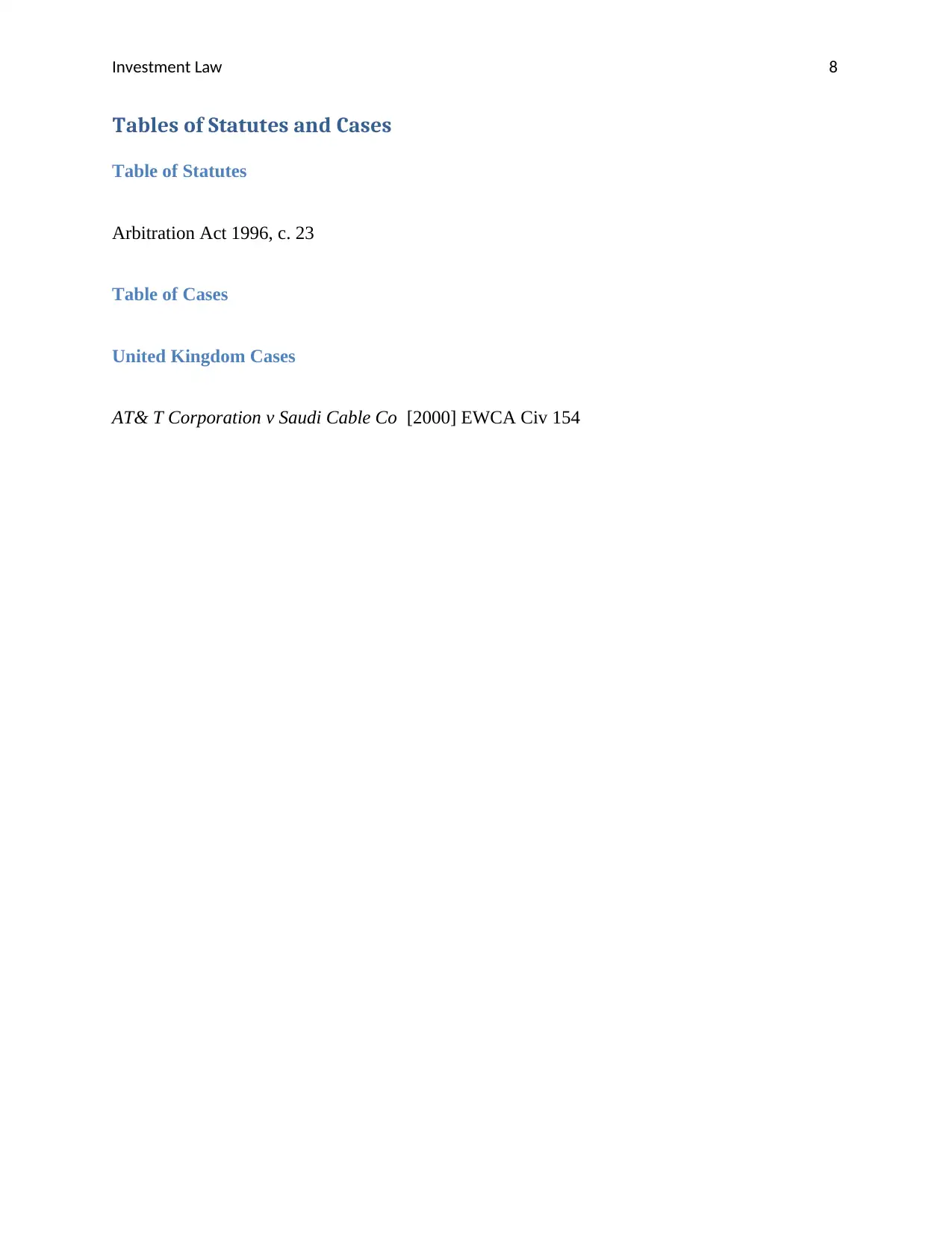
Investment Law 8
Tables of Statutes and Cases
Table of Statutes
Arbitration Act 1996, c. 23
Table of Cases
United Kingdom Cases
AT& T Corporation v Saudi Cable Co [2000] EWCA Civ 154
Tables of Statutes and Cases
Table of Statutes
Arbitration Act 1996, c. 23
Table of Cases
United Kingdom Cases
AT& T Corporation v Saudi Cable Co [2000] EWCA Civ 154
⊘ This is a preview!⊘
Do you want full access?
Subscribe today to unlock all pages.

Trusted by 1+ million students worldwide
1 out of 9
Your All-in-One AI-Powered Toolkit for Academic Success.
+13062052269
info@desklib.com
Available 24*7 on WhatsApp / Email
![[object Object]](/_next/static/media/star-bottom.7253800d.svg)
Unlock your academic potential
Copyright © 2020–2025 A2Z Services. All Rights Reserved. Developed and managed by ZUCOL.


